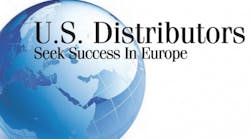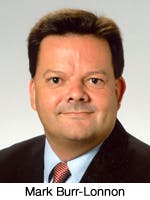Although the Eurozone economy continued to suffer this spring, and the outlook calls for more weakness ahead, U.S.-based distributors remain undeterred in their efforts to grow across the region. Many are capitalizing on ongoing design activity throughout the area while others are growing their production-related business and seeking to build a more global footprint overall.
A handful of those companies spent time at last month’s Electronics Distribution Show in Las Vegas emphasizing their global footprint and outlining plans for growth in Europe. Mouser Electronics, which has grown considerably in Europe over the last few years, is one. Company leaders pointed to its strength as a global operation during the yearly conference, which brings together manufacturers, distributors, and manufacturer representatives. Mouser president Glenn Smith pointed to its record growth in every region in the first quarter of 2013, emphasizing its 19 locations, technical support, customer service, and marketing personnel worldwide.
“Think of us as a global operation that needs to be aligned with your global marketing teams,” Smith told an audience of mostly suppliers during a company update meeting at EDS.
Europe’s Role
That message especially rings true in Europe, which remains Mouser’s fastest-growing region, according to Mark Burr-Lonnon, who heads the distributor’s operations in Europe, the Middle East, and Africa (EMEA). Mouser grew 20%in EMEAlast year and is on track to grow another 25%this year, Burr-Lonnon says. He credits the company’s focus on new product introductions and customer recruitment as keys to that success.
“We have carved a niche with design engineers, focusing on new products,” Burr-Lonnon says. “We’re one of the few guys out there not growing into production [business]. We are where we want to be in Europe and Asia.”
Those positive sentiments come despite Europe’s ongoing economic crisis. The Eurozone’s gross domestic product fell at an annualized rate of 0.9% during the first three months of this year, marking the sixth straight quarter of a recession that began late in 2011. Although economic conditions have improved elsewhere around the world—GDP grew 2.5% in the United States, 2% in the United Kingdom, and 3.5% in Japan during the first quarter—analysts held out little hope that Europe would experience anything resembling a recovery this year. As a result, U.S. distributors are focused on building their brands with a new audience and capitalizing on existing design and production work throughout the region.
Expanding Their Reach
Minnesota-based distributor Digi-Key Corp. is also looking to Europe for growth, although with a different focus. Digi-Key has long served design engineers around the world, but is building business with larger production accounts by placing new resources in Europe. Earlier this year, Digi-Key established an EMEA sales leadership team and added a customer support center in Munich to serve customers in those regions. The distributor also said it will announce more resources covering the Nordics, Baltics, and Eastern and Southern Europe by early summer.
“We’re responding to customer demand for a distribution model that supports today’s changing global business climate,” Chris Beeson, Digi-Key’s vice president, global sales and business development, said when the changes were announced in March. “By recruiting experienced sales leaders, we can more quickly build the Digi-Key brand, increase our traditional business, and support larger production business accounts with one-on-one support.”
Digi-Key’s Europe-based team is divided into four focus areas: EMEA and Asia Pacific; Israel and Russia; the United Kingdom and Ireland; and Central Europe. The team supports a roster of 41,000 EMEA customers and is working to spread the word about Digi-Key to other design engineers and production buyers across each region.
Expansion in Europe is a key part of Digi-Key’s strategy to build out its hybrid distribution model, notes Beeson. Production accounts represented about 33% of Digi-Key’s $1.4 billion in sales in 2012, he says, adding that he expects the production side to hit $615 million in sales this year. Europe’s growing production business represents a small slice of that $615 million, at just about $50 million in business today, leaving plenty of room for growth. Beeson adds that he expects the production business to exceed $1 billion in the next few years.
Digi-Key’s focus on developing the supply chain tools necessary to serve those customers is a key reason for that optimism, but Beeson also points to the distributor’s dedication to inventory and its commitment to delivering “the right product on time all the time” as a premium value in the marketplace.
“Digi-Key is in the inventory business,” Beeson explains. “Our goal is to never let the customer go down.”
Strengthening Ties
Texas-based distributor Allied Electronics is taking a different tack when it comes to globalization, but Europe figures prominently in its approach as well. Owned by Britain-based Electrocomponents plc, Allied is a sister company to Britain-based RS Components, which does business across Europe and around the world. The two companies are working to strengthen their ties, aligning their product portfolios globally and taking advantage of being on a single enterprise resource planning (ERP) system.
“We have two very strong brands, and our intention is to be a stronger global force,” says Phil Dock, global head of product and supplier management for Electrocomponents plc.
Allied spent much of 2011-2012 upgrading to the SAP platform that RS Components was already using. Now the companies are leveraging the strength behind that unified system to create more supply chain visibility and enhance customer-facing services such as design tools, bill of materials management, and quotation and ordering systems. But before they can take full advantage of those capabilities, the companies must work to better align their product portfolios, which company president Scott McLendon says consist of just a 10% overlap in materials now. Though Allied and RS have many of the same suppliers, the product mix looks different around the world.
“In the next five years, our goal is to have a pretty common [product] range around the world—somewhere around 75% common portfolio and the remaining 25% left up to local [needs],” McLendon said in an interview earlier this year. “This allows you to leverage your supply chain better, leverage your demand, make your global inventory visible to your customer base … and then you build your service proposition around that.”
Dock adds that RS Components conducted a similar exercise to unify its product offering across Europe a few years ago, resulting in a £30 million sales increase within 24 months. Global availability can also help on the local level, Dock and McLendon add. As original equipment manufacturers (OEMs) design and build their products in multiple regions, visibility into where the inventory is and how quickly they can access it in a particular location becomes even more important.
“The best global companies look local,” says McLendon. “There are certain things you can leverage globally, but at the end of the day all business is transacted locally.”









